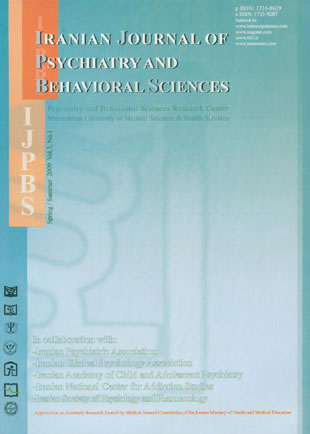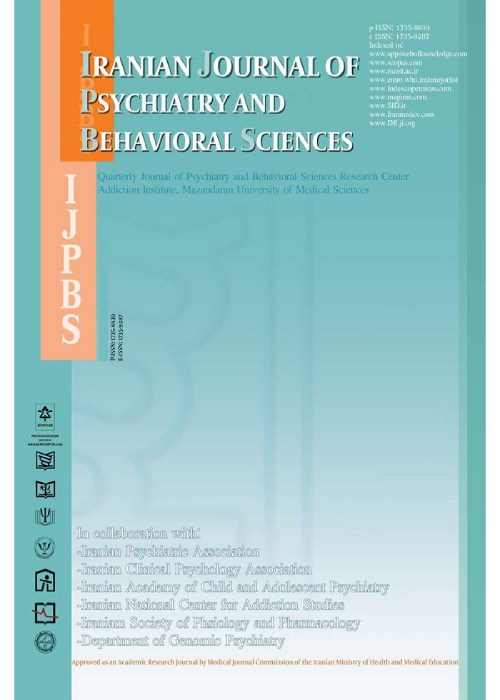فهرست مطالب

Iranian Journal of Psychiatry and Behavioral Sciences
Volume:3 Issue: 1, Jun 2009
- تاریخ انتشار: 1388/02/11
- تعداد عناوین: 17
-
-
Page 1Since 1960s, many experts criticized the use of traditional examinations to assess the skills of medical trainees at all levels and many efforts implemented to create a feasible instrument to measure these skills. Objective Structured Clinical Examination (OSCE) is a modern type of evaluation which is used in many psychiatric and other clinical centers worldwide and has shown a credible validity and reliability. This editorial highlights controversies among advocates and opponents and barriers to appropriate standard performance of this method which has been used in the oral examination of the Board of Psychiatry in Iran since 2006.
-
Page 9In a period of less than five decades, the urban residence has dramatically increased in Iran. Currently more than two thirds of the population live in city dwellings. This rapid urbanization has considerable impact on people’s mental health and psychiatric care. The main strategy of Iran''s National Program of Mental Health has been the integration of mental health into the primary health care (PHC) system. Since 1986, expansion of the integration has resulted in great improvements in the provision of mental health services in rural areas but there is some evidence showing that the integration did not reach its objectives in urban areas where most of the country’s population reside. Recently, some initiatives have been made to face the challenge, for example, home care, aftercare services, and community mental health centers. In any future revision of the national program, mental health care in urban areas should take priority and rethinking the strategies to achieve the goals is necessary.
-
Page 15ObjectiveGiven that the topic of bipolar disorder overdiagnosis has been relatively neglected in the literature and considering its significance in psychiatric training. The present study was conducted through an Objective Structured Clinical Examination (OSCE) on psychiatric residents to assess the validity of their clinical diagnosis.MethodsTwenty forth residents participated in the examination. The first station (the mood disorder station) was designed to explore clinical skill of psychiatric residents in diagnosing major depressive disorder through a clinical interview with a simulated patient. The rating checklist to evaluate the residents included 11 items. Each item was scored on a Likert scale. Two raters completed the checklists independently.ResultsOut of 24 residents, 15 individuals (62.5%) diagnosed major depressive disorder accurately and 9 individuals (37.5%) diagnosed bipolar disorder instead of major depressive disorder. The score of the last psychiatric written exam (p<0.05), the mean score of OSCE on the mood disorder station (p<0.001), and the total score of the OSCE (six stations) (p=0.09) were significantly higher in the group who correctly diagnosed major depressive disorder than the group who did not.ConclusionCurrent study provides evidence for bipolar disorder overdiagnosis and opens up new scopes for improvement in psychiatric training.
-
Page 19ObjectiveWith regard to the abundance of mood disorders among the artists and, life and death of Hedayat, number and time of creation of his works, this hypothesis that Hedayat suffered from a bipolar mood disorder (type II, or bipolar spectrum) is studied in the descriptive psychiatry framework.MethodsHis biographies, medical records, letters exchanged between him and his friends and relatives, and reports by his acquaintances, number and time of creation, form and structure (but not the content of his writings) are scrutinized, assessed and measured according to the strict criteria of contemporary descriptive psychiatry.ResultsIt was shown that besides full blown depressive episodes and two documented attempted suicides (1928 and 1951, the second one led to his death), Hedayat was generally known as a jovial, humorist, lively, and exaggeratedly generous man. It was found out that the rate of creation of his 66 literary works did not follow a steady or monotonous course. Instead, during hypomanic phases he wrote abundantly, but during depressive phases he had no literary creation. In times between, when in a normal mood, he wrote one or two stories in a year. In the three years preceding his completed suicide (1951), he did not write at all and even tore the manuscripts of his unpublished works to pieces some days before suicide.ConclusionThe above findings are all consistent with this conclusion that Sadegh Hedayat suffered from the bipolar mood disorder, type II.
-
Page 27ObjectiveSuicide is one of the most important early causes of death in psychotic patients. The main object of this research was to determine the relationship between positive and negative symptoms of schizophrenia and psychotic major depressive disorder (MDD) with suicidal history and risk.MethodsSixty five patients with schizophrenia compared to 65 patients with psychotic MDD in a cross sectional study. Patients were evaluated using positive and negative syndrome scale (PANSS) (to measure severity of psychopathology) and the California risk estimator for suicide. Collected information were analyzed using SPSS 11/8 version by t-test, chi-square and ANOVA and Pearson correlation test.ResultsThere was a significant relation between positive symptoms with suicidal risk and histories of suicidal attempts in patients with schizophrenia (r= 708, p<0.0001 and r= 0.55, p<0.0001 respectively). Negative symptoms also had a significant but reverse relation with suicidal risk and histories of suicidal attempts in this group (r= -0.529, p<0.0001 and r = -0.512, p<0.0001 respectively). There was a significant reverse relation between positive symptoms and suicidal risk in patients with psychotic MDD (r= -0.26, p<0.036). Negative symptoms did not have a significant relation with suicidal risk in this group. Also there was no significant relation between positive or negative symptoms and histories of suicidal attempts in MDD patients.ConclusionPositive and negative symptoms have different relationships with suicide in patients with schizophrenia and psychotic MDD
-
Relationship between Dimensions of Locus of Control and Mental Health in Iranian University StudentsPage 33ObjectiveMany investigators have attempted to examine the relationship between perceived locus of control and psychological problems. The present study examined this issue on a sample of Iranian University students.MethodsStudy subjects consisted of 134 Iranian University students randomized from seven faculties of Esfahan University of Medical Sciences. The subjects completed the Symptom Checklist-90-R (SCL-90-R) and Levenson`s multidimensions locus of control scale.ResultsResults of the study indicated that subjects who were more internal had lower scores on the SCL-90-R. Higher SCL-90-R scores were associated with belief that life was controlled by powerful others and chance. Findings, also, showed a significantly positive correlation between powerful others locus of control and depression, anxiety, somatization, phobic anxiety and paranoid ideation scores, and between chance locus of control and obsessive-compulsive, depression and somatization scores. Although the positive correlations between external locus of control and interpersonal sensitivity, hostility and psychotism were not significant, the negative correlations between internal locus of control and these subscales scores were significant.ConclusionThe results of this study support some previous findings that all three of Levenson`s scales are associated with measures of maladjustment, with internality negatively correlated and chance and powerful others orientations positively correlated with such measures.
-
Page 38ObjectiveThis study aimed to determine the relations between cognitive variables (self efficacy, locus of control, and dysfunctional attitudes) and psychological morbidities with using doping agents in adolescent athletes.MethodsWe conducted a case-control study in Kermanshah among adolescent athletes using 50 athletic drug users with reported use as a case group and 50 athletic nonusers and 50 nonathletic nonusers as controls that were matched on salient demographics. Controls selected by a simple random sampling. They were then studied by self-efficacy questionnaire, locus of control scale, dysfunctional attitude scale, and general health questionnaire. Hypotheses tested by variance analysis and Tukey’s test.ResultsOur findings showed that athletic drug users had a lower self-efficacy, more dysfunctional attitudes, and exhibited external locus of control rather than control groups. They were also more sensitive to psychological morbidity. Most of relations were statistically significant.ConclusionOur findings were in accordance with the theoretical basis of cognitive psychology and they are comparable to most of the similar studies.
-
Page 44ObjectiveSleep quality affects on physical and psychological well being and even academic functions of students. Indeed, sleep quality has been suggested as an individual index of general health. Among adolescents and young adults, poor sleep quality is common. The aim of this survey was to determine the sleep quality and its correlation with general health in 18-year-old Iranian students.MethodsSimple random sampling was used to select 1000 students from all of the Karaj non-private pre-university schools for this cross sectional study. These students were asked to complete two self-report questionnaires; Pittsburgh Sleep Quality Index and General Health Questionnaire-28. Nine hundred and forty three students were entered into the final analysis.ResultsPoor sleep quality and poor general health were observed in 56% and 42% of participants, respectively. In both of them the difference between boys and girls was significant (P<0.05). Poor general health was noticed in 55% of students with poor sleep quality. Also, there were a positive correlation between sleep quality and general health.ConclusionThe prevalence of poor sleep quality in Iranian pre-university students is higher than that of many other countries. Further researches are required for finding the etiology.
-
Page 50ObjectiveSpouse abuse is a worldwide health concern with prevalent psychiatric and medical consequences in victims. The present study was conducted to determine the prevalence of spouse abuse among a group of women living in Tehran and survey their mental health status.MethodsTotally, 1186 married women were selected through a randomized systematic sampling from 22 districts of Tehran. Initial data were obtained by demographic questionnaire, Spouse Abuse Questionnaire (SAQ) and General Health Questionnaire - 28 (GHQ-28). Data were analyzed using Student''s unpaired t-test or χ2 test, when appropriate.ResultsOf 1186 women, 980 (82.6%) were physically and sexually abused, however, 818 (68.9%) were physically and emotionally and 835 (70.5%) were sexually and emotionally abused by their husbands. Spouse abused women, especially emotionally and physically abused clients had higher GHQ-28 scores in all the components of the test while their differences with non-abused women were statistically significant. This is interpreted as poor mental health status among these victims.ConclusionOur results revealed the high prevalence of maltreatment against women living in Tehran. Meanwhile, our victims were more commonly suffered from anxiety and depressive disorders and achieved poor mental health status and low social performance.
-
Page 57ObjectiveIt is an established fact that violence co-occurs with intimate partners in families. The aim of this study was investigation of similarities and differences between intimacy and violence patterns in married college students.MethodsThree questionnaires were used: 1. Marital intimacy questionnaire-Persian form. 2. Aggression questionnaire and 3. General demographic questionnaire. 198 married college students were randomly selected from Tehran Universities. They answered individually to the questionnaires. The data were analyzed by t-test, chi-square and correlation coefficients.ResultsThere were no significant gender differences in total score of intimacy and other dimensions of intimacy. But there were significant differences between genders according to total the score of violence (p<0.05), physical (p<0.05), sexual (p<0.05) and verbal patterns of violence (P<0.0001). There were also correlations between some dimensions of intimacy and violent patterns.ConclusionGender differences revealed important similarities and distinctions in husbands and wives'' patterns of intimacy and violence. Couples with increasing intimacy dimensions can control the violent patterns of behavior. Satisfaction in close relationships depends on active participation of both partners.
-
Page 62ObjectiveThe purpose of this study was to identify reasons domestic violence occurs within intimate relationships.MethodsThe target group was female victims and male offenders. The offenders group consisted of 25 men from a batterer’s intervention group. The victims group composed of 9 women from Center Against Spouse Abuse (CASA) intervention group.ResultsDomestic violence occurred at a higher rate in intimate relationships where either the victim or offender has been exposed to prior domestic violence. A higher percentage of victimized women were in a lower economic class than male offenders.ConclusionDomestic violence perpetuates the future cycle of violence.
-
CalendarPage 91


